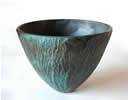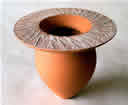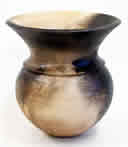Magic upon nature
Shahid Mirza
Courtesy: The Friday Times, Lahore
Exhibition of by ceramic works by Irish artist Michael Rice at Zahoor Ul-Ikhlaq gallery, NCA, Lahore from 4-7th December 2006.
 We are a ‘clay culture’ for millennia. The river valleys of Indus system are a permanent source of the supply of clay that takes various forms; fashioned from dried mud and terracotta are objects ornamental, symbolic and functional. Pottery making has evolved from a simple craft into a highly specialized aesthetic expression, even though the materials and tools are few but the range of imagination is vast and varied. Ranging from houses to pots, lamps and toys artistic clay modeling and pot making remains the most important index of the material culture of early human history. We are a ‘clay culture’ for millennia. The river valleys of Indus system are a permanent source of the supply of clay that takes various forms; fashioned from dried mud and terracotta are objects ornamental, symbolic and functional. Pottery making has evolved from a simple craft into a highly specialized aesthetic expression, even though the materials and tools are few but the range of imagination is vast and varied. Ranging from houses to pots, lamps and toys artistic clay modeling and pot making remains the most important index of the material culture of early human history.
Kumbhar, the potter caste is integral to the peasant society. Like most vocations pottery making is a hereditary and monopolistic occupation, the whole family works together as a unit thus the development of techniques and tools is credited more to the group than to the individual potter, overtime it becomes a cultural trait of a living tradition.
The government agencies have opened three institutes for glass, ceramics & blue pottery in Lahore, Gujrat and Multan to impart instruction in new techniques, materials and manufacturing but for lack of modern facilities, good management, funds and initiative, the potters family workshop continues to be more educative than the institutes.
 The ceramics department of the National College of Arts, Lahore invited Michael Rice for a two-month residency program and the present body of work was created during his stay. Michael lives in Northern Ireland where he teaches and manages a ceramic workshop. He is very impressed with the students whom he finds creative, observant and religious; a quality that he believes would help them explore the spiritual dimension of their work. Seeing the works exhibited, pondering and contemplating each piece one cannot help but discover that excluding the obvious traditional techniques specific to certain countries it is impossible to determine borders or the national origin of a given work. The ceramics department of the National College of Arts, Lahore invited Michael Rice for a two-month residency program and the present body of work was created during his stay. Michael lives in Northern Ireland where he teaches and manages a ceramic workshop. He is very impressed with the students whom he finds creative, observant and religious; a quality that he believes would help them explore the spiritual dimension of their work. Seeing the works exhibited, pondering and contemplating each piece one cannot help but discover that excluding the obvious traditional techniques specific to certain countries it is impossible to determine borders or the national origin of a given work.
Walking through the exhibition one is overwhelmed by the quietude, poise and symmetry of his works. The egg shape is basic to the innovations of the potter’s wheel; the organic profile appears repeatedly in Michael’s work but the subtle variations in shape, color and texture of the non-utilitarian works give every piece a distinct appearance and impression.
 I am “making a statement not sayings” tells Michael, “and the aim is to make it well and beautiful.” The artistic content, technical sophistication and originality makes his work surprising and intense. An incessant fluid line encircles the subterranean browns and lustrous greens of his heavily textured surfaces. Etched with subtle marks, suggestive lines and abstract patterns, resting on slim base, his pieces swell, ascend and open out; filled by the air inside the form ripens and than converges to an abstract point in proximate space. Suspended between invisible ends the illusive material turns to form in human viewing, it becomes. I am “making a statement not sayings” tells Michael, “and the aim is to make it well and beautiful.” The artistic content, technical sophistication and originality makes his work surprising and intense. An incessant fluid line encircles the subterranean browns and lustrous greens of his heavily textured surfaces. Etched with subtle marks, suggestive lines and abstract patterns, resting on slim base, his pieces swell, ascend and open out; filled by the air inside the form ripens and than converges to an abstract point in proximate space. Suspended between invisible ends the illusive material turns to form in human viewing, it becomes.
 Wheel throwing is the method of choice for Michael; the process is simple but systematic as it involves at least eleven rapidly changing stages. A lump of clay is placed on the wheel head while it is rotated; the potter shapes the lump with his fingers. The pots are than beaten, enlarged and shaved, glazes are applied and the piece is polished, relief designs are completed and the pot is ready for firing in a Kiln. The local Kilns feed on wood and take 7/8 hours of strenuous work for one session; in the developed world, electrical computerized Kilns and quality supply stores have made pottery-making more accessible. Wheel throwing is the method of choice for Michael; the process is simple but systematic as it involves at least eleven rapidly changing stages. A lump of clay is placed on the wheel head while it is rotated; the potter shapes the lump with his fingers. The pots are than beaten, enlarged and shaved, glazes are applied and the piece is polished, relief designs are completed and the pot is ready for firing in a Kiln. The local Kilns feed on wood and take 7/8 hours of strenuous work for one session; in the developed world, electrical computerized Kilns and quality supply stores have made pottery-making more accessible.
 The potters of Gujrat are famous for making drinking bowls that weigh only one Tola (approximately 10 grams) since the conventional potters treat weight as a measure of skill so I could not resist questioning why his pieces are so heavy. “Weight is only important if it is functional” perkily replied Michael and quoted his Japanese mentor Takeshi Yasuds “if you can pick it up it is not heavy.” Later he confessed that being used to sophisticated equipment that gives perfect results and no breakage he destroyed his first entire lot in firing, as the wares were very thin and he had not learnt control of local old kiln. The potters of Gujrat are famous for making drinking bowls that weigh only one Tola (approximately 10 grams) since the conventional potters treat weight as a measure of skill so I could not resist questioning why his pieces are so heavy. “Weight is only important if it is functional” perkily replied Michael and quoted his Japanese mentor Takeshi Yasuds “if you can pick it up it is not heavy.” Later he confessed that being used to sophisticated equipment that gives perfect results and no breakage he destroyed his first entire lot in firing, as the wares were very thin and he had not learnt control of local old kiln.
For glazing he uses the ancient method called Terra Sigiliatta, a process of making fine clay which is later polished, much like polishing a shoe the pots are burnished by a piece of cloth, pebble or glass beads for achieving brightness and depth of color.
 The mechanically made symmetrical objects like bottles, vases and bowls always appear asymmetrical to the human eye. Visual correction is a familiar practice in architecture, the Greek columns incorporate several optical devices, often not in themselves visible to the human eye but intended to correct undesirable visual effects created by the form. These devices include a subtle tampering and inward slant or increased thickness of the columns at corners. In wheel-pottery, a perfectly symmetrical form is finished visually; the conspicuously simple pieces evoke balance and quiet, much like identifying with the hero of a film or novel the art viewer can identify with equilibrium in this work, equilibrium that we lack in reality. The mechanically made symmetrical objects like bottles, vases and bowls always appear asymmetrical to the human eye. Visual correction is a familiar practice in architecture, the Greek columns incorporate several optical devices, often not in themselves visible to the human eye but intended to correct undesirable visual effects created by the form. These devices include a subtle tampering and inward slant or increased thickness of the columns at corners. In wheel-pottery, a perfectly symmetrical form is finished visually; the conspicuously simple pieces evoke balance and quiet, much like identifying with the hero of a film or novel the art viewer can identify with equilibrium in this work, equilibrium that we lack in reality.
Michael complains that lack of funds and modern equipment hinders growth of the NCA ceramic department. Tahir khan a local ceramist visiting the exhibition disagrees that the students will benefit by using state of the art equipment. “They will have to set up there own workshops after graduating and wont be able to afford this expensive equipment” he argues “and will either stop working or come back to local materials and technology, so why not start from there?”
 Since local materials and methods were central to our discussion I asked Michael if he had worked with any traditional potter or seen there work during his stint at NCA, sadly his answer was a plain “no.” This took me to Shazia Waseem, head of NCA ceramic department, she was frank in admitting that they had ‘never’ invited a local potter to instruct, assist or even view the work produced here. She wondered what could be gained through such interaction, a view shared by her student who remarked “why would we go to them, we are doing creative things here and they have nothing to offer.” Nevertheless, both conceded that they go to the Kumbhar for assistance if they have to do something big and complicated. Since local materials and methods were central to our discussion I asked Michael if he had worked with any traditional potter or seen there work during his stint at NCA, sadly his answer was a plain “no.” This took me to Shazia Waseem, head of NCA ceramic department, she was frank in admitting that they had ‘never’ invited a local potter to instruct, assist or even view the work produced here. She wondered what could be gained through such interaction, a view shared by her student who remarked “why would we go to them, we are doing creative things here and they have nothing to offer.” Nevertheless, both conceded that they go to the Kumbhar for assistance if they have to do something big and complicated.
Picasso explained, “When you make a thing, a thing that is new, it is so complicated making it that it is bound to be ugly. But those that make it after you, they don’t have to worry about making it. And they can make it pretty, and so everybody can like it when the others make it after you.” |
![]()


![]()